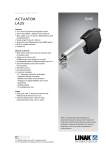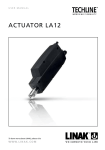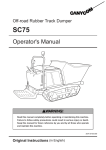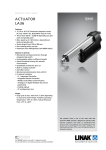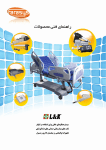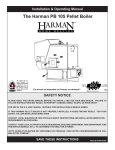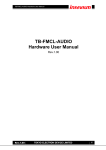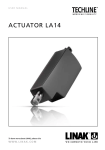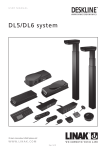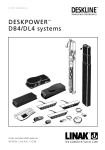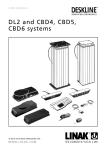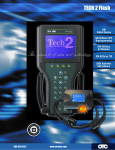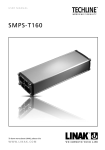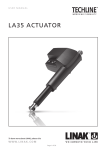Download ACTUATOR LA25
Transcript
USER MANUAL ACTUATOR LA25 To learn more about LINAK, please visit: W W W. L I N A K . C O M Page 1 of 60 Page 2 of 60 Contents Preface.................................................................................................................................................5 LINAK application policy........................................................................................................................6 Chapter 1 Safety instructions............................................................................................................................. 7-8 Chapter 2 Mounting guidelines....................................................................................................................... 9-10 Mounting of cables.............................................................................................................................11 Electrical installation:...........................................................................................................................12 Recommended fuse...................................................................................................................12 Actuator without feedback........................................................................................................13 Actuator with: Endstop signal output................................................................................................. 14-15 Relative positioning - Single Hall.................................................................................. 16-17 Endstop signals and relative positioning - Single Hall................................................... 18-19 Absolute positioning - Analogue feedback.................................................................. 20-21 Endstop signals and absolute positioning - Analogue feedback................................... 22-23 Absolute positioning - PWM....................................................................................... 24-25 Endstop signals and absolute positioning - PWM......................................................... 26-27 IC Basic....................................................................................................................... 28-30 IC Advanced - with BusLink......................................................................................... 31-33 Correct wiring of Power GND and Signal GND for IC Basic and IC Advanced.....................34 Actuator with Parallel.................................................................................................. 35-37 The parallel system............................................................................................................... 38-39 System monitoring for Parallel....................................................................................................40 Alignment of the parallel actuator system..................................................................................40 Parallel manual service mode.....................................................................................................41 Page 3 of 60 Contents Chapter 3 Troubleshooting............................................................................................................................ 42-43 Troubleshooting for Parallel........................................................................................................... 44-46 Chapter 4 Specifications......................................................................................................................................47 Usage.................................................................................................................................................47 Actuator dimensions...........................................................................................................................48 Stroke tolerances................................................................................................................................48 Built-in tolerances...............................................................................................................................48 Speed and current curves:...................................................................................................................49 12V motor....................................................................................................................................49 24V motor....................................................................................................................................50 Test of conducted and radiated emission.............................................................................................51 Label for LA25....................................................................................................................................52 Key to symbols....................................................................................................................................52 LA25 Ordering example......................................................................................................................53 Chapter 5 Maintenance.......................................................................................................................................54 Repair.................................................................................................................................................54 Main groups of disposal......................................................................................................................54 Warranty ...........................................................................................................................................55 Declaration of conformity...................................................................................................................56 Declaration of incorporation of partly completed machinery................................................................57 Adresses.............................................................................................................................................60 Page 4 of 60 Preface Dear User, We are delighted that you have chosen a product from LINAK®. LINAK systems are high-tech products based on many years of experience in the manufacture and development of actuators, electric control boxes, controls, and chargers. This user manual does not address the end-user, but is intended as a source of information for the manufacturer of the equipment or system only, and it will tell you how to install, use and maintain your LINAK electronics. It is the responsibility of the manufacturer of the end-use product to provide a User Manual where relevant safety information from this manual is passed on to the end-user. We are sure that your LINAK product/system will give you many years of problem-free operation. Before our products leave the factory they undergo full function and quality testing. Should you nevertheless experience problems with your LINAK product/system, you are always welcome to contact your local dealer. LINAK subsidiaries and some distributors situated all over the world have authorised service centres, which are always ready to help you. LINAK provides a warranty on all its products. This warranty, however, is subject to correct use in accordance with the specifications, maintenance being done correctly and any repairs being carried out at a service centre, which is authorised to repair LINAK products. Changes in installation and use of LINAK products/systems can affect their operation and durability. The products are not to be opened by unauthorised personnel. The User Manual has been written based on our present technical knowledge. We are constantly working on updating the information and we therefore reserve the right to carry out technical modifications. LINAK A/S Page 5 of 60 LINAK application policy The purpose of the application policy is to define areas of responsibilities in relation to applying a LINAK product defined as hardware, software, technical advice, etc. related to an existing or a new customer application. LINAK products as defined above are applicable for a wide range of applications within Medical, Furniture, Desk, and Industry areas. Yet, LINAK cannot know all the conditions under which LINAK products will be installed, used, and operated, as each individual application is unique. The suitability and functionality of the LINAK product and its performance under varying conditions (application, vibration, load, humidity, temperature, frequency, etc.) can only be verified by testing, and shall ultimately be the responsibility of the LINAK customer using any LINAK product. LINAK shall be responsible solely that LINAK products comply with the specifications set out by LINAK and it shall be the responsibility of the LINAK customer to ensure that the specific LINAK product can be used for the application in question. Page 6 of 60 Chapter 1 Safety instructions Please read this safety information carefully: Be aware of the following three symbols throughout the user manual: Warning! Failing to follow these instructions can cause accidents resulting in serious personal injury. Recommendations Failing to follow these instructions can result in the actuator suffering damage or being ruined. Additional information Usage tips or additional information that is important in connection with the use of the actuator. Furthermore, ensure that all staff who are to connect, mount, or use the actuator are in possession of the necessary information and that they have access to this user manual. Persons who do not have the necessary experience or knowledge of the product/products must not use the product/products. Besides, persons with reduced physical or mental abilities must not use the product/products, unless they are under surveillance or they have been thoroughly instructed in the use of the apparatus by a person who is responsible for the safety of these persons. Moreover, children must be under surveillance to ensure that they do not play with the product. Before you start mounting/dismounting, ensure that the following points are observed: • The actuator is not in operation. • The actuator is free from loads that could be released during this work. Before you put the actuator into operation, check the following: • The actuator is correctly mounted as indicated in the relevant user instructions. • The equipment can be freely moved over the actuator’s whole working area. • The actuator is connected to a mains electricity supply/transformer with the correct voltage and which is dimensioned and adapted to the actuator in question. • Ensure that the voltage applied matches to the voltage specified on the actuator label. • Ensure that the connection bolts can withstand the wear. • Ensure that the connection bolts are secured safely. Page 7 of 60 During operation, please be aware of the following: • Listen for unusual sounds and watch out for uneven running. Stop the actuator immediately if anything unusual is observed. • Do not sideload the actuator. • Only use the actuator within the specified working limits. • Do not step or kick on the actuator. When the equipment is not in use: • Switch off the mains supply in order to prevent unintentional operation. • Check regularly for extraordinary wear. Classification The equipment is not suitable for use in the presence of a flammable anaesthetic mixture with air or with oxygen or nitrous oxide. Warnings • Do not sideload the actuator. • When mounting the actuator in the application ensure that the bolts can withstand the wear and that they are secured safely. • If irregularities are observed, the actuator must be replaced. • For actuators with a stroke length below 50mm, the extended position of the mechanical endstop will always be at 50mm. That means, if an actuator has a stroke of 20mm and the endstop switch in outwards direction fails, the actuator will travel additional 30mm before reaching mechanical endstop. Recommendations • Do not place load on the actuator housing and do prevent impact or blows, or any other form of stress to the housing. • Ensure that the cable cover is mounted correctly. Use 1.5Nm torque. • Ensure that the duty cycle and the usage temperatures for LA25 actuators are respected. • Ensure that the cable cannot be squeezed, pulled or subjected to any other stress. • Furthermore, it will be good practice to ensure that the actuator is fully retracted in the “normal” position. The reason is that there will be a vacuum inside the actuator if it is extended which over time can lead to water entering the actuator. • If the actuator (without integrated controller) is mounted in an application where a mechanical stop prevents the endstop switches in the actuator from being activated, the actuator must be equipped with an electrical safety device (current monitoring) or external limit switch. Page 8 of 60 Chapter 2 Mounting guidelines LINAK® linear actuators are quickly and easily mounted by slipping pins through the holes on each end of the units and into brackets on the machine frame and the load. The mounting pins must be parallel to each other as shown in Figure 1. Pins, which are not parallel to each other, may cause the actuator to bend and be damaged. Figure 1 The load should act along the stroke axis of the actuator as off-centre loads may cause bending and lead to premature failure. See Figure 2. Make sure the mounting pins are supported in both ends. Failure to do so could shorten the life of the actuator. Also, avoid applying a skew load on the actuator. The actuator can rotate around the pivot point in the front and rear end. If this is the case it is of high importance that the actuator is able to move freely over the full stroke length, both during the development and daily operation. Please pay special attention to the area around the housing where parts can be trapped and cause damage to the application and actuator. In applications with high dynamic forces LINAK recommends not to use the fully extended or retracted position over longer time, as this can damage the endstop system permanently. Figure 2 Right Wrong Wrong Page 9 of 60 Wrong Mounting guidelines • The mounting pins must have the correct dimension • The bolts and nuts must be made of a high quality steel grade (e.g. 10.8). No thread on the bolt inside the back fixture or the piston rod eye • Bolts and nuts must be protected so there is no risk for them to fall out • Do not use a torque that is too high when mounting the bolts for the back fixture or the piston rod eye. This will stress the fixtures Please note: The piston rod eye is only allowed to turn 0-90 degrees. Instruction concerning the turning of the piston rod eye and inner tube: • When mounting and taking into use, it is not permitted to make excessive turns of the piston rod eye. In cases where the eye is not positioned correctly, it is permitted to first screw the eye down to its bottom position, at a maximum torque of 2Nm (1), and 030618/DS thereafter a maximum 90 degrees turn outwards again (2). • vedr. uddrejning af inderrør – LA27 + LA27C As the piston rodInstruktion eye can turn freely, it is important to ensure that the eye cannot Til salesbackup, brugsanvisning og datablad. rotate if the actuator is used in a pull application. If this happens, the actuator will be Ved montage og ibrugtagning, er det ikke tilladt at dreje unødvendigt mange gange på pulled apart and destroyed. stempelstangsrøret. Hvis øjet ikke er positioneret korrekt, er det tilladt først at skrue røret i bund (1), og derefter skrue det maksimalt ½ omgang ud igen (2). Warning! If the actuator is used for pull in an application where personal injury can occur, the following is valid: It is the application manufacturer’s responsibility to incorporate a suitable safety arrangement, which will prevent personal injury from occurring, if the actuator should fail Warning! LINAK’s actuators are not designed for use within the following fields: •Offshore installations • Explosive environments •Aeroplanes and other aircraft • Nuclear power generation Page 10 of 60 Mounting of cables 1. Unscrew the cover 2. Remove the cover 3. Plug in the cable gently without using any tools Removing cables 4. Screw the cover back onto the actuator 5. Use a screwdriver to pull up the cable The torque of the cover screw is approx. 1.5 Nm • When changing the cables on a LINAK actuator, it is important that this is done carefully, in order to protect the plugs and pins. Before the new cable is mounted, we recommend that the socket is greased with vaseline, to keep the high IP protection and ensure an easy mounting. Please be sure that the plug is in the right location and fully pressed in before the cable lid is mounted. • We recommend to take some precaution and design the wire connection in a way, where the cable end is kept inside a closed, protected area to guarantee the high IP protection. Page 11 of 60 Electrical installation • • To ensure maximum self-locking ability, please be sure that the motor is shorted when stopped. Actuators with integrated controller have this feature incorporated. When using soft stop on a DC-motor, a short peak of higher voltage will be sent back towards the power supply. It is important when selecting the power supply that it does not turn off the output, when this backwards load dump occurs. The power supply for actuators without integrated controller must be monitored externally and cut off in case of overload. Recommended fuse for actuators without integrated controller Type Spindle Pitch (mm) Thrust max. Push/Pull (N) Typical Amp. Recommended at full load fuse (A) 24V - 12V 24V - 12V 25030xxxxxxxxA... 3 2500 - 3.8 - 10A 25060xxxxxxxxA... 6 1500 - 3.8 - 10A 25090xxxxxxxxA... 9 1200 - 4.0 - 10A 25120xxxxxxxxA... 12 900 - 3.8 - 10A 25030xxxxxxxxB... 3 2500 1.9 - 6A - 25060xxxxxxxxB... 6 1500 1.9 - 6A - 25090xxxxxxxxB... 9 1200 2.0 - 6A - 25120xxxxxxxxB... 12 900 1.9 - 6A - Page 12 of 60 Actuator without feedback Connection diagram: Fig. 1 : 25xxxxxxxx000x0x=xxxxx00xxxxxx BROWN BLUE I/O specifications: Input/Output Specification Comments Description Permanent magnetic DC motor. See connection diagram, fig. 1 above 12-24VDC (+/-) To extend actuator: Connect Brown to positive 12V ± 20% 24V ± 10% To retract actuator: Connect Brown to negative Under normal conditions: 12V, max. 5A depending on load 24V, max. 2.5A depending on load To extend actuator: Connect Blue to negative Brown Blue Red Not to be connected Black Not to be connected Green Not to be connected Yellow Not to be connected Violet Not to be connected White Not to be connected Page 13 of 60 To retract actuator: Connect Blue to positive Actuator with endstop signal output Connection diagram: Fig. 2 : 25xxxxxxxx000x0x=xxxxx10xxxxxx BROWN BLUE + RED YELLOW* IN OUT GREEN* - BLACK *YELLOW/GREEN: Endstop signals out are NOT potential free! If you wish to use the endstop signals, you will have to keep power on the brown, blue, red and black wires, otherwise the signal will be lost. Page 14 of 60 Actuator with endstop signal output I/O specifications: Input/Output Specification Comments Description The actuator can be equipped with electronically controlled endstop signals out. See connection diagram, fig. 2, page 14 Brown Blue Red IN OUT 12-24VDC (+/-) To extend actuator: Connect Brown to positive 12V ± 20% 24V ± 10% To retract actuator: Connect Brown to negative Under normal conditions: 12V, max. 5A depending on load 24V, max. 2.5A depending on load To extend actuator: Connect Blue to negative Signal power supply (+) 12-24VDC Black Signal power supply GND (-) Green Endstop signal out Yellow Endstop signal in Violet Not to be connected White Not to be connected To retract actuator: Connect Blue to positive Current consumption: Max. 40mA, also when the actuator is not running Output voltage min. VIN - 2V Source current max. 100mA NOT potential free Page 15 of 60 Actuator with relative positioning - Single Hall Connection diagram: Fig. 3 : 25xxxxxxxx0K0x0x=xxxxx00xxxxxx BROWN BLUE + RED VIOLET - BLACK Page 16 of 60 Actuator with relative positioning - Single Hall I/O specifications: Input/Output Specification Comments Description The actuator can be equipped with Single Hall that gives a relative positioning feedback signal when the actuator moves. See connection diagram, fig. 3, page 16 Brown 12-24VDC (+/-) To extend actuator: Connect Brown to positive 12V ± 20% 24V ± 10% To retract actuator: Connect Brown to negative Under normal conditions: 12V, max. 5A depending on load 24V, max. 2.5A depending on load To extend actuator: Connect Blue to negative Red Signal power supply (+) 12-24VDC Black Signal power supply GND (-) Current consumption: Max. 40 mA, also when the actuator is not running Green Not to be connected Yellow Not to be connected Violet Single Hall output (PNP) Blue To retract actuator: Connect Blue to positive Output voltage min. VIN - 2V Max. current output: 12mA LA25030 Actuator = 0.25 mm per pulse Max. 680 nF Movement per single Hall pulse: LA25060 Actuator = 0.5 mm per pulse LA25090 Actuator = 0.75 mm per pulse LA25120 Actuator = 1.0 mm per pulse Frequency: Frequency is 10-20Hz on Single Hall output depending on load. Pulse ON time is minimum 8ms. OFF time between two ON pulses is minimum 8ms. Overvoltage on the motor can result in shorter pulses. Diagram of Single Hall: Hall A Low frequency with a high load. Higher frequency with no load. Input Single Hall output Micro Processor Hall B White N.B. For more precise measurements, please contact LINAK A/S. Fig. 3.1 Not to be connected Page 17 of 60 Actuator with endstop signals and relative positioning - Single Hall Connection diagram: Fig. 4 : 25xxxxxxxx0K0x0x=xxxxx10xxxxxx BROWN BLUE + IN OUT RED YELLOW* GREEN* VIOLET - BLACK *YELLOW/GREEN: Endstop signals out are NOT potential free!(See I/O Specifications, page 14) If you wish to use the endstop signals, you will have to keep power on the brown, blue, red and black wires, otherwise the signal will be lost. Page 18 of 60 Actuator with endstop signals and relative positioning - Single Hall I/O specifications: Input/Output Specification Comments Description The actuator can be equipped with Single Hall that gives a relative positioning feedback signal when the actuator moves. See connection diagram, fig. 4, page 18 12-24VDC (+/-) To extend actuator: Connect Brown to positive 12V ± 20% 24V ± 10% To retract actuator: Connect Brown to negative Under normal conditions: 12V, max. 5A depending on load 24V, max. 2.5A depending on load To extend actuator: Connect Blue to negative Red Signal power supply (+) 12-24VDC Black Signal power supply GND (-) Current consumption: Max. 40mA, also when the actuator is not running Green Endstop signal out Yellow Endstop signal in Violet Single Hall output (PNP) Brown Blue To retract actuator: Connect Blue to positive Output voltage min. VIN - 2V Source current max. 100mA NOT potential free Output voltage min. VIN - 2V Max. current output: 12mA LA25030 Actuator = 0.25 mm per pulse Max. 680nF Movement per single Hall pulse: LA25060 Actuator = 0.5 mm per pulse LA25090 Actuator = 0.75 mm per pulse LA25120 Actuator = 1.0 mm per pulse Frequency: Frequency is 10-20Hz on Single Hall output depending on load. Pulse ON time is minimum 8ms. OFF time between two ON pulses is minimum 8ms. Overvoltage on the motor can result in shorter pulses. Diagram of Single Hall: Hall A Low frequency with a high load. Higher frequency with no load. Input Single Hall output Micro Processor Hall B White N.B. For more precise measurements, please contact LINAK A/S. Fig. 4.1 Not to be connected Page 19 of 60 Actuator with absolute positioning - Analogue feedback Connection diagram: Fig. 5 : 25xxxxxxxx0A0x0x=xxxxx0xxxxxxx BROWN BLUE + RED VIOLET - BLACK Page 20 of 60 Actuator with absolute positioning - Analogue feedback I/O specifications: Input/Output Specification Comments Description The actuator can be equipped with electronic circuit that gives an analogue feedback signal when the actuator moves. See connection diagram, fig. 5, page 20 Brown Blue 12 - 24 V DC (+/-) To extend actuator: Connect Brown to positive 12V ± 20% 24V ± 10% To retract actuator: Connect Brown to negative Under normal conditions: 12V, max. 5A depending on load 24V, max. 2.5A depending on load To extend actuator: Connect Blue to negative Red Signal power supply (+) 12 - 24 V DC Black Signal power supply GND (-) Green Not to be connected Yellow Not to be connected Violet Analogue feedback 0-10V (Feedback level 1) 0.5-4.5V (Feedback level 2) 4-20mA (Feedback level 3) Special (Feedback level 9) To retract actuator: Connect Blue to positive Current consumption: Max. 60 mA, also when the actuator is not running Tolerances +/- 0.2 V Max. current output: 1 mA Ripple max. 200 mV Transaction delay max. 20 ms Linear feedback 0.5% Source current max. 1 mA Tolerances +/- 0.2 mA Transaction delay 20ms Linear feedback 0.5% Output: Source Serial resistance: 12V max 300 ohm 24V max. 900 ohm For all analogue feedbacks it is recommendable to have the actuator to activate its limit switches on a regular basis, to ensure more precise positioning White Not to be connected Page 21 of 60 Actuator with endstop signals and absolute positioning Analogue feedback Connection diagram: Fig. 6 : 25xxxxxxxx0A0x0x=xxxxx1xxxxxxx BROWN BLUE + RED IN OUT YELLOW* Signal VIOLET GREEN* - BLACK *YELLOW/GREEN: Endstop signals out are NOT potential free!(See I/O Specifications, page 14) If you wish to use the endstop signals, you will have to keep power on the brown, blue, red and black wires, otherwise the signal will be lost. Page 22 of 60 Actuator with endstop signals and absolute positioning Analogue feedback I/O specifications: Input/Output Specification Comments Description The actuator can be equipped with electronic circuit that gives an analogue feedback signal when the actuator moves. See connection diagram, fig. 6, page 22 12-24VDC (+/-) To extend actuator: Connect Brown to positive 12V ± 20% 24V ± 10% To retract actuator: Connect Brown to negative Under normal conditions: 12V, max. 5A depending on load 24V, max. 2.5A depending on load To extend actuator: Connect Blue to negative Brown Blue Red Signal power supply (+) 12-24VDC Black Signal power supply GND (-) Green Endstop signal out Yellow Endstop signal in Violet Analogue feedback To retract actuator: Connect Blue to positive Current consumption: Max. 60mA, also when the actuator is not running Output voltage min. VIN - 2V Source current max. 100mA NOT potential free 0-10V (Feedback level 1) 0.5-4.5V (Feedback level 2) 4-20mA (Feedback level 3) Special (Feedback level 9) Tolerances +/- 0.2V Max. current output: 1mA Ripple max. 200mV Transaction delay max. 20ms Linear feedback 0.5% Source current max. 1mA Tolerances +/- 0.2mA Transaction delay 20ms Linear feedback 0.5% Output: Source Serial resistance: 12V max 300 ohm 24V max. 900 ohm For all analogue feedbacks it is recommendable to have the actuator to activate its limit switches on a regular basis, to ensure more precise positioning White Not to be connected Page 23 of 60 Actuator with absolute positioning - PWM Connection diagram: Fig. 7 : 25xxxxxxxx0F0x0x=xxxxx0xxxxxxx BROWN BLUE + RED VIOLET - BLACK Page 24 of 60 Actuator with absolute positioning - PWM I/O specifications: Input/Output Specification Comments Description The actuator can be equipped with electronic circuit that gives an analogue feedback signal when the actuator moves. See connection diagram, fig. 7, page 24 Brown 12-24VDC (+/-) To extend actuator: Connect Brown to positive 12V ± 20% 24V ± 10% To retract actuator: Connect Brown to negative Under normal conditions: 12V, max. 5A depending on load 24V, max. 2.5A depending on load To extend actuator: Connect Blue to negative Red Signal power supply (+) 12-24VDC Black Signal power supply GND (-) Current consumption: Max. 40 mA, also when the actuator is not running Green Not to be connected Yellow Not to be connected Violet Digital output feedback Blue White 10-90% (Feedback level 4) 20-80% (Feedback level 5) Special (Feedback level 9) Not to be connected Page 25 of 60 To retract actuator: Connect Blue to positive Output voltage min. VIN - 2V Tolerances +/- 2% Max. current output: 12mA It is recommendable to have the actuator to activate its limit switches on a regular basis, to ensure more precise positioning Actuator with endstop signals and absolute positioning - PWM Connection diagram: Fig. 8 : 25xxxxxxxx0F0x0x=xxxxx1xxxxxxx BROWN BLUE + IN OUT RED YELLOW* GREEN* VIOLET - BLACK *YELLOW/GREEN: Endstop signals out are NOT potential free! (See I/O Specifications, page 14) If you wish to use the endstop signals, you will have to keep power on the brown, blue, red and black wires, otherwise the signal will be lost. Page 26 of 60 Actuator with endstop signals and absolute positioning - PWM I/O specifications: Input/Output Specification Comments Description The actuator can be equipped with electronic circuit that gives an analogue feedback signal when the actuator moves. See connection diagram, fig. 8, page 26 12-24VDC (+/-) To extend actuator: Connect Brown to positive 12V ± 20% 24V ± 10% To retract actuator: Connect Brown to negative Under normal conditions: 12V, max. 5A depending on load 24V, max. 2.5A depending on load To extend actuator: Connect Blue to negative Red Signal power supply (+) 12-24VDC Black Signal power supply GND (-) Current consumption: Max. 40mA, also when the actuator is not running Green Endstop signal out Yellow Endstop signal in Violet Digital output feedback Brown Blue White To retract actuator: Connect Blue to positive Output voltage min. VIN - 2V Source current max. 100mA NOT potential free 10-90% 20-80% (Feedback level 4) (Feedback level 5) Special (Feedback level 9) Not to be connected Page 27 of 60 Output voltage min. VIN - 2V Tolerances +/- 2% Max. current output: 12mA It is recommendable to have the actuator to activate its limit switches on a regular basis, to ensure more precise positioning Actuator with IC Basic Connection diagram: Fig. 9 : 25xxxxxxxxxx3x1x=xxxxx0xxxxxxx BROWN 12/24V DC BLUE INWARDS M BLACK OUTWARDS RED Hall FEEDBACK VIOLET 0-10V SIGNAL GND WHITE H-Bridge Please be aware that if the power supply is not properly connected, you might damage the actuator! Page 28 of 60 Actuator with IC Basic I/O specifications: Input/Output Specification Comments Description Easy to use interface with integrated power electronics (H-bridge). The actuator can also be equipped with electronic circuit that gives an asolute or relative feedback signal. The version with “IC option” cannot be operated with PWM (power supply). M H-Bridge See connection diagram, fig. 9, page 28 Brown 12-24VDC + (VCC) Connect Brown to positive 12V ± 20% 24V ± 10% 12V, current limit 8A 24V, current limit 5A Blue 12-24VDC - (GND) Connect Blue to negative 12V ± 20% 24V ± 10% 12V, current limit 8A 24V, current limit 5A Note: Do not change the power supply polarity on the brown and blue wires! Power supply GND (-) is electrically connected to the housing If the temperature drops below -10°C, all current limits will automatically increase to 9A for 12V, and 6A for 24V Red Extends the actuator On/off voltages: Black Retracts the actuator > 67% of VIN = ON < 33% of VIN = OFF Input current: 10mA Green Not to be connected Yellow Not to be connected Page 29 of 60 Actuator with IC Basic I/O specifications: Input/Output Specification Comment Violet Analogue feedback Standby power consumption: 12V, 60mA 24V, 45mA 0-10V (Feedback level 1) Ripple max. 200mV Transaction delay 20ms Linear feedback 0.5% Max. current output: 1mA It is recommendable to have the actuator to activate its limit switches on a regular basis, to ensure more precise positioning. White Single Hall output (PNP) Output voltage min. VIN - 2V Max. current output: 12mA For more information see fig. 3.1, page 17 Signal GND For correct wiring of power GND and Signal GND see page 34 Page 30 of 60 Actuator with IC Advanced - with BusLink Connection diagram: Fig. 10 : 25xxxxxxxxxx3x1x=xxxxx1xxxxxxx BROWN 12/24V DC BLUE BLACK INWARDS M OUTWARDS H-Bridge IN OUT RED YELLOW GREEN Hall FEEDBACK VIOLET SIGNAL GND WHITE 0-10V 50% 50% PWM 4-20mA Please be aware that if the power supply is not properly connected, you might damage the actuator! BusLink is available for IC Advanced and can be used for: Diagnostics, manual run and configuration Download BusLink software here: http://www.linak.com/techline/?id3=2363 For more information and easy set-up of BusLink, please follow this link to view the Quick Guide for BusLink: http://www.linak.com/techline/?id3=2356 Page 31 of 60 Actuator with IC Advanced - with BusLink I/O specifications: Input/Output Specification Comments Description Easy to use interface with integrated power electronics (H-bridge). The actuator can also be equipped with electronic circuit that gives an absolute or relative feedback signal. IC Advanced provides a wide range of possibilities for customisation. The version with “IC option” cannot be operated with PWM (power supply). M H-Bridge See connection diagram, fig. 10, page 31 Brown 12-24VDC + (VCC) Connect Brown to positive 12V ± 20% 24V ± 10% 12V, current limit 8A 24V, current limit 5A Blue Note: Do not change the power supply polarity on the brown and blue wires! Power supply GND (-) is electrically connected to the housing 12-24VDC - (GND) Connect Blue to negative Current limit levels can be adjusted through BusLink 12V ± 20% 24V ± 10% If the temperature drops below -10°C, all current limits will automatically increase to 9A for 12V, and 6A for 24V 12V, current limit 8A 24V, current limit 5A Red Extends the actuator On/off voltages: Black Retracts the actuator > 67% of VIN = ON < 33% of VIN = OFF Input current: 10mA Green Endstop signal out Output voltage min. VIN - 2V Source current max. 100mA Endstop signals are NOT potential free. Endstop signals can be configured with BusLink software according to any position needed. Yellow Endstop signal in Before configuring virtual endstop, an absolute feedback type must be chosen. Only use one virtual endstop - keep one end open for initilisation. (See I/O specifications for endstop on page 14). Page 32 of 60 Actuator with IC Advanced - with BusLink I/O specifications: Input/Output Specification Comment Violet Analogue feedback (0-10V): Ripple max. 200mV Configure any high/low combination Transaction delay 20ms between 0-10V Linear feedback 0.5% Max. current output. 1mA Single Hall output (PNP) Output voltage min. VIN - 2V Max. current output: 12mA Please be aware that when choosing single hall, feedback position readout and virtual endstops are not available in BusLink. For more information, see fig. 4.1, page 19 Digital output feedback PWM: Configure any high/low combination between 0-100% Output voltage min. VIN - 2V Frequency: 75Hz ± 10Hz as standard, but this can be customised. Duty cycle: Any low/high combination between 0 and 100 percent. Open Drain source current max. 12mA Analogue feedback (4-20mA): Tolerances +/- 0.2mA Configure any high/low combination Transaction delay 20ms between 4-20mA Linear feedback 0.5% Output: Source Serial resistance: 12V max. 300 ohm 24V max. 900 ohm All absolute value feedbacks (0-10V, PWM and 4-20mA) Standby power consumption: 12V, 60mA 24V, 45mA It is recommendable to have the actuator to activate its limit switches on a regular basis, to ensure more precise positioning White Signal GND For correct wiring of power GND and Signal GND see page 34 Item number for BusLink cables: 0147999 Please note that the BusLink cables must be purchased separately from the actuator! Page 33 of 60 Correct wiring of Power GND and Sinal GND for IC Basic and IC Advanced When using the feedback output, it is important to use the right connection setup. Attention should be paid to the two ground connections. Power GND in the Power connector and Signal GND in the Control connector. When using either 0-10V, Hall or PWM feedback, the Signal GND must be used. For optimal accuracy, the Signal GND is connected to the Power GND as close as possible to the feedback input equipment. Power connector POWER BROWN POWER GND BLUE Power supply Control connector Hall FEEDBACK VIOLET 0-10V 50% 50% 50% 50% Feedback input PWM SIGNAL GND WHITE 4-20mA LA25 IC actuator Please note that this section only applies for the following feedback options: 0-10V, Hall and PWM. Page 34 of 60 Actuator with Parallel Connection diagram: Fig. 11 : 25xxxxxxxxxx3x1x=xxxxx1Zxxxxxx Actuator 8 Actuator 7 Actuator 6 Actuator 5 Actuator 4 Actuator 3 Actuator 2 Actuator 1 BROWN Communication Communication IN OUT 12/24V DC Communication IN OUT Communication IN OUT INWARDS BLUE Communication IN OUT INWARDS M H-Bridge OUTWARDS H-Bridge Communication VIOLET Communication WHITE IN OUT INWARDS M Communication IN OUT INWARDS M OUTWARDS H-Bridge IN OUT INWARDS M OUTWARDS H-Bridge IN OUT YELLOW GREEN INWARDS M OUTWARDS H-Bridge INWARDS M OUTWARDS H-Bridge M OUTWARDS H-Bridge INWARDS BLACK M OUTWARDS H-Bridge OUTWARDS RED • Please be aware that if the power supply is not properly connected, you might damage the actuator! • The green and yellow wires from parallel connected actuators must NOT be interconnected. Page 35 of 60 Actuator with Parallel I/O specifications: Input/Output Specification Comments Description Parallel drive of up to 8 actuators. A master actuator with an integrated H-bridge controller controls up to 7 slaves. The version with “IC option” cannot be operated with PWM (power supply). M H-Bridge M H-Bridge M H-Bridge H-Bridge See connection diagram, fig. 11, page 35 Brown 12-24VDC + (VCC) Connect Brown to positive 12V ± 20% 24V ± 10% 12V, current limit 8A 24V, current limit 5A Blue 12-24VDC - (GND) Connect Blue to negative 12V ± 20% 24V ± 10% 12V, current limit 8A 24V, current limit 5A Red Extends the actuator M Note: Do not change the power supply polarity on the brown and blue wires! The parallel actuators can run on one OR separate power supplies Power supply GND (-) is electrically connected to the housing Current limit levels can be adjusted through BusLink (only one actuator at a time for parallel) If the temperature drops below -10°C, all current limits will automatically increase to 9A for 12V, and 6A for 24V On/off voltages: > 67% of VIN = ON < 33% of VIN = OFF Input current: 10mA Black Retracts the actuator Green Endstop signal out Yellow Endstop signal in It does not matter where the in/ out signals are applied. You can either choose to connect the signal cable to one actuator OR you can choose to connect the signal cable to each actuator on the line. Either way this will ensure parallel drive Output voltage min. VIN - 2V Source current max. 100mA NOT potential free Page 36 of 60 Actuator with Parallel I/O specifications: Input/Output Specification Comment Violet Parallel communication: Violet cords must be connected together Standby power consumption: 12V, 60mA 24V, 45mA No feedback available during parallel drive White Signal GND: White cords must be connected together Page 37 of 60 For correct wiring of power GND and Signal GND see page 34 The parallel system The parallel drive function will support a number of actuators working jointly. + Power Supply 12/24V Power Supply 12/24V + BLUE Power Supply 12/24V + - - Power Supply 12/24V + - BROWN RED BLACK VIOLET Communication WHITE Signal GND YELLOW GREEN BLACK (IN) RED (OUT) ENDSTOP IN ENDSTOP OUT Controller/ Rocker Switch • It is both possible to run parallel with a single power supply, or to run each actuator with separate power supplies. • Only standard power and signal cables are available for parallel. Page 38 of 60 The parallel system • It does not matter where the IN/OUT signal is applied. The signals of all actuators can be connected together • When all actuators are connected, a Master will automatically be chosen. E.g. with 5 actuators in one system there will be 1 Master and 4 Slaves. The Master can control up to 7 slaves • If an overload occurs, the running of the actuators will be stopped and blocked in that direction until an activation in the opposite direction has been made, or the system has been re-powered • Before entering BusLink mode, all actuators must be disconnected. It is only possible to configure one actuator at a time through BusLink •When changing the actuator configuration, it is important that all actuators in the system have the same configuration before the system starts running. Otherwise, the actuators will not run • Actuators will be pre-programmed from our production as 2, 3, 4, 5.. etc. parallel systems. Through BusLink it will be possible to add or remove actuators to/from the system • In case one of the actuators are broken, the system will not move; not even after re-powering. The broken actuator needs to be replaced, before the system can run again. The system will only run, when it is complete BusLink is available for Parallel • BusLink can be used for configuration and diagnostics • Service counter is available with Parallel Download BusLink software here: http://www.linak.com/techline/?id3=2363 For more information and easy set-up of BusLink, please follow this link to view the Quick Guide for BusLink: http://www.linak.com/techline/?id3=2356 Please note that the BusLink cables must be purchased separately from the actuator! Item number for BusLink cables: 0147999 Page 39 of 60 System Monitoring for Parallel If one of the actuators have one of the following error conditions, the actuator will immediately STOP: • • • • • • • • H-Bridge fault Out of the temperature range (High duty cycle protection) Overcurrent (Current cut-off if one or all actuators go in mechanical block) SMPS fault EOS fault switch Hall sensor failure Position lost Overvoltage (43V DC) Alignment of the parallel actuator system If the actuators are not in parallel when starting up, the next movement will run in the following manner: Start position Running outwards When completely aligned, the parallel run continues outwards Start position Running inwards When completely aligned, the parallel run continues inwards Page 40 of 60 Parallel manual service mode With the parallel manual service mode it is possible to drive one or more parallel actuators separately, using the red and black wire from each actuator. Please follow this procedure to manually extend/retract the parallel actuator(s): Procedure Min. Max. First step Disconnect the Purple and White wires between all actuators - - Hold Put power on the Red and Black wires for 10-30 seconds 10 sec. 30 sec. Difference The Red and Black wires must all be connected to the power supply within 0.5 seconds 0 sec. 0.5 sec. Release Disconnect all wires and wait 0.5-2 0.5 sec. seconds before the next step 2 sec. Extend/Retract Now choose either to extend or retract the actuator: - - To extend the actuator: Connect only the Red wire(s) to the power supply To retract the actuator: Connect only the Black wire(s) to the power supply Interval Switch between running in/out as much as needed, without exceeding the 2.0 seconds interval between disconnecting/connecting the Red and Black wires - 2 sec. End To exit the parallel manual mode, diconnect the Red and Black wires for more than 2.0 seconds 2 sec. - Back to parallel mode Before running in standard parallel mode, reconnect all Purple and White wires - - Hold Release End Interval Run out Difference Difference Run in Page 41 of 60 Chapter 3 Troubleshooting Symptom Possible cause Action No motor sound or movement of piston rod The actuator is not properly connected to the power supply Customer fuse burned Cable damaged • Check the connection to the power supply or the external control unit (if any) To extend actuator: Connect Brown to positive and Blue to negative To retract actuator: Connect Brown to negative and Blue to positive • Change cable IC: Wrongly connected: + Brown, - Blue • Check wire connection (Red/ Black) on control unit Signal required for moving outwards: + VCC -> RED Wire • Please contact LINAK Signal required for moving inwards: + VCC -> Black Wire Excessive electricity Consumption Misalignment or overload in application • Align or reduce load • Try to run the actuator without load • Please contact LINAK Motor runs but spindle does not move Gearing system or spindle damaged • Please contact LINAK Actuator cannot lift full load Clutch is worn Motor is damaged Insufficient power supply • Align or reduce load • Check power supply IC: Current cut off (overload in application) For IC advanced and Parallel only: Connect actuator to BusLink and check the current parameters (inwards/outwards) • Please contact LINAK Page 42 of 60 Troubleshooting Symptom Possible cause Action No signal from Feedback Wrongly Connected: • Check wiring Violet: Signal out White: Signal GND Yellow: Endstop In Green: Endstop Out Cable damaged Bad connection Potentiometer damaged Hall sensor or magnet damaged • Change cable For IC Advanced only: Check Feedback option - connect to BusLink For IC Advanced only: Connect actuator to BusLink and check current parameters. Initialise the actuator in both directions • Please contact LINAK Motor runs too slowly Load is higher than specified Voltage drop in cable (Use of long or does not run with cables can negatively affect the full force performance of the actuator) Motor runs in smaller Insufficient power supply steps IC: Current Cut-off • Reduce load Actuator(s) cannot hold the chosen load • Reduce load Load is higher than specified Page 43 of 60 • Check power supply IC: Connect actuator to BusLink and check current parameters (reason for last stop). For more info, please see page 45 Troubleshooting for Parallel Symptom Possible cause Action No actuators in movement Power supply • Check power supply source and power connections: Brown + Blue Please be aware that if the power supply is not properly connected, you might damage the actuator Signal connections • Check parallel communications: Violet = Communication Violet cords must be connected together White = Signal GND White cords must be connected together Signal required for moving outwards: + VCC (Red wire) • Check wire connection (Red/ Black) on control unit Signal required for moving inwards: + VCC (Black wire) • Put power on all actuators at the same time, after everything is connected. Then wait 10 seconds before signals for moving In/Out are activated Actuator(s) cannot lift full load Load is higher than specified • Reduce load • Check for sufficient power supply current • Connect actuator via BusLink one at the time and check monitoring for each actuator (reason for last stop) Short movements before stops Actuator NOT connected properly • Check wire connection (Violet/ White) Violet = Parallel communication White = Signal GND • If OK - Connect actuators via BusLink one at the time and check monitoring for each actuator (reason for last stop). For more info, please see page 45 Page 44 of 60 Troubleshooting for Parallel Symptom Possible cause Action Signal cable damaged All actuators stop at the same or removed under position operation • When seeing a communication error, the system goes into ‘position lost’ • The signal and power cables MUST be connected to all actuators again • Afterwards, the Parallel system needs re-powering • If one actuator is missing, the system will not work, not even after re-powering BusLink monitoring: Reason for last stop H-bridge fault • Please contact your local supplier for further instructions SMPS fault Overcurrent • The Parallel system cannot continue in the same direction • Reactivation is needed in the opposite direction EOS OUT error • The Parallel system stops at the same time. When seeing an EOS error, the actuator goes into ‘position lost’, and the system will need initialisation (to initialise, move the actuators into fully retracted position) EOS IN error Hall error • The system stops at the same position. When seeing hall error, the actuator goes into ‘position lost’, and the system will need initialisation (to initialise, move the actuators into fully retracted position) Out of range temperature for ambient location • The error causes the actuators to stop. After elimination of the error (cooling down) and reactivation of the movement, the actuators will move normally Out of range temperature at FET location The above can be due to high environment temperature or high duty cycle Page 45 of 60 • This may not be used for stop of the system Troubleshooting for Parallel Symptom Possible cause Action BusLink monitoring: Reason for last stop Overvoltage • When seeing overvoltage, the system stops at the same time. The system needs re-powering and In/Out signals must be removed before next movement Undervoltage • When seeing undervoltage, the system stops at the same time. The system needs re-powering and In/Out signals must be removed before next movement For more information and easy set-up of BusLink, please follow this link to view the Quick Guide for BusLink: http://www.linak.com/techline/?id3=2356 Page 46 of 60 Chapter 4 Specifications Motor: Permanent magnet motor 12VDC or 24VDC Cable: Motor: 8 x 18 AWG PVC cable Housing: The housing is made of casted aluminium, coated for outdoor use and in harsh conditions Spindle part: Outer tube: Extruded aluminium anodised Inner tube: Stainless steel AISI304/SS2333 Acme spindle: Trapezoidal spindle with high efficiency Temperature range: - 40o C to +85o C - 40o F to +185o F Full performance +5o C to +40o C End play: 2 mm maximum Weather protection: Rated IP66 for outdoor use. Furthermore, the actuator can be washed down with a high-pressure cleaner (IP69K) Compatibility: The LA25 is compatible with SMPS-T160 (For combination possibilities, please see the User Manual for SMPS-T160) Usage: • The duty cycle at max. load is 20%. This means that is the actuator runs continuously for 20 seconds, it must remain off for 80 seconds before operating again • Storage temperature: -55°C to + 105°C • Noise level: • With standard motor: Max. 58.5 dB (A) Measuring method DS/EN ISO 3743-1 actuator not loaded Safety device regarding functional failure: Safety nut The LA25 has a built-in safety nut in push as an option. Actuators with a safety nut in push can only function when used in push applications. The safety nut comes into operation should the main nut fail. Afterwards, it is only possible to drive the actuator into the innermost position. Then, the actuator will not function anymore and it must be sent for service. The same functionality, but in the opposite direction, goes for actuators with a safety nut in pull Mechanical endstop LA25 is equipped with mechanical endstop Page 47 of 60 Actuator dimensions TECHLINE® LA25: Stroke tolerances Descriptions Stroke tolerance Example for 200mm stroke 25XXXXXXXXXX0 With built-in limit switches +2 / - 2mm 198 to 202mm 25XXXXXXXXXX3 Integrated controller +1 / -3mm 197 to 201mm Platform options Built-in tolerances Platform options Descriptions BID tolerance Example for 200 mm BID 25XXXXXXXXXXX All variants +2 / -2 mm 198 to 202 mm Page 48 of 60 Speed and current curves - 12V motor The values below are typical values and made with a stable power supply and an ambient temperature of 20˚ C. LA25 - 12V Speed vs Thrust 14 12 12mm pitch Speed [mm/s] 10 8 9mm pitch 3mm pitch 6mm pitch 6 9mm pitch 6mm pitch 12mm pitch 4 3mm pitch 2 0 0 500 1000 1500 2000 2500 3000 Thrust [N] LA25 - 12V Current vs Thrust 4,5 12mm pitch 4 9mm pitch 6mm pitch 3mm pitch 3,5 Current [A] 3 2,5 3mm pitch 6mm pitch 2 9mm pitch 1,5 12mm pitch 1 0,5 0 0 500 1000 1500 Thrust [N] Page 49 of 60 2000 2500 3000 Speed and current curves - 24V motor The values below are typical values and made with a stable power supply and an ambient temperature of 20˚ C. LA25 - 24V Speed vs Thrust 14 12 12mm pitch Speed [mm/s] 10 9mm pitch 8 3mm pitc 6mm pitch 6 6mm pitc 9mm pitc 12mm pit 4 3mm pitch 2 0 0 500 1000 1500 2000 2500 3000 Thrust [N] LA25 - 24V Current vs Thrust 2 12mm pitch 1,8 9mm pitch 3mm pitch 6mm pitch 1,6 Current [A] 1,4 1,2 3mm pitch 1 6mm pitch 0,8 9mm pitch 12mm pitch 0,6 0,4 0,2 0 0 500 1000 1500 Thrust [N] Page 50 of 60 2000 2500 3000 Test of conducted and radiated emission (EMC) All TECHLINE actuators have been tested in accordance with EN55011 class B (2007) (CISPR 11). A 1m cable has been used in the test set-up. Actuator without H-bridge 1)For normal operation the following is valid: • Radiated emission requirements are met. • Conducted emission requirements are met. However, to meet with these requirements a capacitor has been mounted across the motor wires outside the actuator, and tests have then been made with this capacitor. Capacitor values for some of the TECHLINE actuators can be found in the scheme below. To comply with EN55011 class B (2007) a capacitor must be added across the motor wires, or the connected control box must have similar/better filtering. The actuator is not delivered with a built in capacitor, because then it would not be possible to PWM the motor for those who would want to do that. Please view the scheme below for the correct choice of capacitor for the actuator in question. Product Capacitor value LA25 1 µF 2)For systems/operations that use PWM-control it is up to the customer to test and meet the requirements. Actuator with H-bridge 1)For normal operation with soft start/stop the following is valid: • The actuator has been tested when operating with constant 80%-PWM. • Radiated emission requirements are met. • Conducted emission requirements are met. 2) For systems with LINAK PWM regulation (among other things parallel operation and speed regulation) the following is valid: • Radiated emission requirements are met. • Conducted emission requirements are met. 3)Speed regulation: • If the speed is regulated below a nominal speed of 80% (80%-PWM), it is necessary to mount a filter in order to comply with the conducted emission requirements. For systems/operations that are speed regulated, it is up to the customer to test and meet the requirements. Page 51 of 60 Label for LA25 1.Type: 25120108000A3B1A=C1CCS1A000 Describes the basic functionality of the product 2.Item no.: J90161 Sales and ordering code 3.Prod. Date: YYYY.MM.DD Production date describes when the product has been produced. This date is the reference for warranty claims 4.Max Load: Push 900N / Pull 900N IP66 Describes the maximum load that the product can be exposed to in compression and tension. This line also contains a reference to the product’s IP protection degree 5.Power Rate: 24VDC / Max. 2.3 Amp Input voltage for the product and maximum current consumption 6.Duty Cycle: 20%, Max. 2 min. / 8 min. The duty cycle defines the maximum period during operation without interruption. After operation, a pause must be observed. It is important that the operator follows the instructions of the duty cycle; otherwise, a possible overload may result in reduced product life/errors 7.W/O# 1234567-0001 The LINAK work order followed by a unique sequential identification number Key to symbols The following symbols are used on the LA25 label. Symbol Norms Approvals WEEE Directive 2002/96/EC Wheelie bin Compliance to all relevant EC directives CE C-Tick 2002: The Australian EMC C-Tick China Pollution control mark (also indicates recyclability) China RoHS legislation ISO 7000- 0434A: Caution Operating instructions Page 52 of 60 LA25 ordering example 2 5 P P P X X X S S F F P M E E = B R E P C E F L 0 0 X X X 1 3 6 9 11 12 13 14 15 16 17 18 19 20 21 22 23 24 25 26 27 28 29 30 2 4 5 7 8 10 XXX = BID (mm) 0 = Not specified 0 = Not specified Loadtype 0 = Push/Pull 1 = Push 2 = Pull * Feedback level by platform type None 0 = none 1 = 0 - 10 V 2 = 0.5 - 4.5 V 3 = 4 - 20 mA 4 = 10 - 90 % 5 = 20 - 80 % 9 = Special IC type Basic 0 = none 1 = 0 - 10 V EOS (End Of Stroke) output IC type Advanced 0 = none A = 0 - 10 V B = 0.5 - 4.5 V C = 4 - 20 mA D = 10 - 90 % E = 20 - 80 % X = Special IC type Parallel Z = Parallel 0 = No (only IC Basic) 1 = Yes (only IC Advanced) Cable: 0 = None S = Straight 0.75m T = Straight 1.5m (8-core, Note: If AMP is chosen = 6-core) R = Straight 5.0m (8-core, Note: If AMP is chosen = 6-core) X = Special Plug Type: 0 = None C = Flying leads J = Deutsch (DT4) K= AMP superseal X = Special Is to be chosen, if cable and connectors are not wanted Is to be chosen, if connector is not wanted Piston Rod Eye: 1 = Zink coated steel ø10,2 (0231033) 2 = Zink coated steel + bushings ø10.2 3 = Zink coated ø 12.3 (0231016) 4 = Zinc coated steel + bushings ø 8.1 X = special A = Stainless ø10.2 (0231096) B = Stainless + bushings ø10.2 C = Stainless ø 12.3 (0231095) D = Stainless steel + bushings ø 8.1 Backfixture rotation 1 = 0 degrees 2 = 90 degrees Back fixture type: 1 = Zink coated steel ø10.2 (0251011) 2 = Zink coated steel + bushings ø10.2 3 = Zink coated ø 12.3 (0251010) 4 = Zinc coated steel + bushings ø 8.1 X = special * A = Stainless ø10.2 (0251015) B = Stainless + bushings ø10.2 C = Stainless ø 12.3 (0251014) D = Stainless steel + bushings ø 8.1 Colour : = = DarkGrey IP: A= IP66 + IP69K 9 = Harsh environment housing + IP66/IP69K (Special article number only) Endstop : 0 = Power switch (Platform none) 1 = Signalswitch (Platform IC) Motor Type: A = 12VDC normal B = 24VDC Normal Platform 0 = None 3 = IC Integrated Controller Feedback 00 = None 0K = Single Hall 0A = Hall Potentiometer (Analogue feedback) 0F = PWM Safety : 00 = None 0A = Safety nut Stroke Length: XXX = mm Spindle Pitch: 030 = 3 mm 060 = 6 mm 090 = 9 mm 120 = 12 mm Actuator Type: 25 = LA25 IC options: IC LINbus Parallel LA25 actuator: � � � Page 53 of 60 Chapter 5 Maintenance • The actuator must be cleaned at regular intervals to remove dust and dirt and inspected for mechanical damages or wear. • Inspect attachment points, wires, piston rod, cabinet, and plug, as well as check that the actuator functions correctly. • To ensure that the pregreased inner tube remains lubricated, the actuator must only be washed down when the piston rod is fully retracted. • The actuator is a closed unit and therefore requires no internal maintenance. • In order to maintain a proper performance of the spherical eyes and to increase the resistance against environmental wear, we strongly recommend that the spherical eyes (ball bearings) mounted on actuators from LINAK are greased with anticorrosive grease or similar. Repair Only an authorised LINAK® service centre should repair LINAK actuator systems. Systems to be repaired under warranty must be sent to an authorised LINAK service centre. In order to avoid the risk of malfunction, all actuator repairs must only be carried out by an authorised LINAK Service shop or repairer, as special tools and parts must be used. If a system is opened by unauthorised personel there is a risk that it may malfunction at a later date. Main groups of disposal LINAK’s products may be disposed of, possibly by dividing them into different waste groups for recycling or combustion. Product LA25 Metal scrap Cable scrap Electronic scrap Plastic recycling or combustion X X X X We recommend that our product is disassembled as much as possible at the disposal and that you try to recycle it. Page 54 of 60 Warranty There is an 18 months’ warranty on TECHLINE products against manufacturing faults calculated from the production date of the individual products (see label). LINAK’s warranty is only valid in so far as the equipment has been used and maintained correctly and has not been tampered with. Furthermore, the actuator must not be exposed to violent treatment. In the event of this, the warranty will be ineffective/ invalid. For further details, please see standard terms of sale and delivery for LINAK A/S. Note: Only an authorised LINAK® service centre should repair LINAK actuator systems. Systems to be repaired under warranty must be sent to an authorised LINAK service centre. In order to avoid the risk of malfunction, all actuator repairs must only be carried out by an authorised LINAK Service shop or repairer, as special tools and parts must be used. If a system is opened by unauthorised personel there is a risk that it may malfunction at a later date. The actuator is not to be opened by unauthorised personnel. In case the actuator is opened, the warranty will be invalid. Page 55 of 60 Declaration of conformity DECLARATION OF CONFORMITY LINAK A/S Smedevænget 8 DK - 6430 Nordborg Hereby declares that Actuator 25XXXXXXXX000XXXXXXXXXXXXXX, 25XXXXXXXX0K0XXXXXXXXXXXXXX, 25XXXXXXXX0A0XXXXXXXXXXXXXX, 25XXXXXXXX0F0XXXXXXXXXXXXXX complies with the EMC Directive: 2004/108/EC according to following harmonized standards: EN61000-4-2:2009, EN6100-4-3:2006+A1+A2, EN61000-4-4:2012, EN61000-4-5:2007, EN61000-4-6:2009, EN61000-4-8:2010, EN55016-2-1:2009+A1, EN55016-2-3:2010+A1, EN55025:2008 Additional information: The device does comply with the generic standard: EN 61000-6-1:2007, Electromagnetic compatibility (EMC) - Part 6-1: Generic standards - Immunity for residential, commercial and light-industrial environments EN 61000-6-2:2005, Electromagnetic compatibility (EMC) - Part 6-2: Generic standards - Immunity for industrial environments EN 61000-6-3:2007, Electromagnetic compatibility (EMC) - Part Part 6-3: Generic standards - Emission standard for residential, commercial and light-industrial environments EN 61000-6-4:2007, Electromagnetic compatibility (EMC) - Part 6-4: Generic standards - Emission standard for industrial environments The device does also comply with the standard: ISO 10605:2008, Road vehicles -- Test methods for electrical disturbances from electrostatic discharge ISO 11452-4:2005, Road vehicles -- Component test methods for electrical disturbances from narrowband radiated electromagnetic energy -- Part 4: Harness excitation methods ISO 11452-2:2004, Road vehicles -- Component test methods for electrical disturbances from narrowband radiated electromagnetic energy -- Part 2: Absorber-lined shielded enclosure ISO 7637-2:2004, Road vehicles -- Electrical disturbances from conduction and coupling -- Part 2: Electrical transient conduction along supply lines only Nordborg, 2014-05-02 LINAK A/S John Kling, B.Sc.E.E. Certification and Regulatory Affairs Authorized to compile the relevant technical documentation Original declaration Page 56 of 60 DECLARATION OF INCORPORATION OF PARTLY COMPLETED MACHINERY LINAK A/S Smedevænget 8 DK - 6430 Nordborg Herewith declares that LINAK TECHLINE ® products as characterized by the following models and types: Linear Actuators LA12, LA14, LA22, LA23, LA25, LA30, LA35, LA36, LA37 comply with the following parts of the Machinery Directive 2006/42/EC, ANNEX I, Essential health and safety requirements relating to the design and construction of machinery: 1.5.1 Electricity supply The relevant technical documentation is compiled in accordance with part B of Annex VII and that this documentation or part hereof will be transmitted by post or electronically to a reasoned request by the national authorities. This partly completed machinery must not be put into service until the final machinery into which it is to be incorporated has been declared in conformity with the provisions of the Machinery Directive 2006/42/EC where appropriate. Nordborg, 2014-10-20 LINAK A/S John Kling, B.Sc.E.E. Certification and Regulatory Affairs Authorized to compile the relevant technical documentation Original Declaration Page 57 of 60 Page 58 of 60 Page 59 of 60 FACTORIES CHINA LINAK (Shenzhen) Actuator Systems, Ltd. Phone: +86 755 8610 6656 Fax: +86 755 8610 6990 E-mail: [email protected] www.linak.cn DENMARK SLOVAKIA LINAK A/S - Group Headquarters, Guderup Phone: +45 73 15 15 15 Fax: +45 74 45 80 48 Fax: +45 73 15 16 13 (Sales) E-mail: [email protected] www.linak.com LINAK Slovakia s.r.o. Phone: +421 51 75 63 414 Fax: +421 51 75 63 410 E-mail: [email protected] www.linak.com USA LINAK U.S. Inc. North and South American Headquarters Phone: +1 502 253 5595 Fax: +1 502 253 5596 E-mail: [email protected] www.linak-us.com SUBSIDIARIES DENMARK ITALY NORWAY SWITZERLAND LINAK Australia Pty. Ltd Phone: +61 3 8796 9777 Fax: +61 3 8796 9778 E-mail: [email protected] www.linak.com.au LINAK Danmark A/S Phone: +45 86 80 36 11 Fax: +45 86 82 90 51 E-mail: [email protected] www.linak.dk LINAK Italia S.r.l. Phone: +39 02 48 46 33 66 Fax: +39 02 48 46 82 52 E-mail: [email protected] www.linak.it LINAK Norge AS Phone: +47 32 82 90 90 Fax: +47 32 82 90 98 E-mail: [email protected] www.linak.no LINAK AG Phone: +41 43 388 31 88 Fax: +41 43 388 31 87 E-mail: [email protected] www.linak.ch AUSTRIA FINLAND JAPAN POLAND TAIWAN LINAK Repräsentanz Österreich (Wien) Phone: +43 (1) 890 7446 Fax: +43 (1) 890 744615 E-mail: [email protected] www.linak.at LINAK OY Phone: +358 10 841 8700 Fax: +358 10 841 8729 E-mail: [email protected] www.linak.fi LINAK K.K. Phone: 81-45-533-0802 Fax: 81-45-533-0803 E-mail: [email protected] www.linak.jp LINAK Polska Phone: +48 (22) 500 28 74 Fax: +48 (22) 500 28 75 E-mail: [email protected] www.linak.pl BELGIUM & LUXEMBOURG LINAK A/S Taiwan Representative Office Phone: +886 2 27290068 Fax: +886 2 27290096 Mobile: +886 989292100 E-mail: [email protected] www.linak.com.tw FRANCE MALAYSIA REPUBLIC OF KOREA LINAK Actuator-Systems NV/SA Phone: +32 (0)9 230 01 09 Fax: +32 (0)9 230 88 80 E-mail: [email protected] www.linak.be LINAK France E.U.R.L Phone: +33 (0) 2 41 36 34 34 Fax: +33 (0) 2 41 36 35 00 E-mail: [email protected] www.linak.fr LINAK Actuators Sdn. Bhd. Phone: +60 4 210 6500 Fax: +60 4 226 8901 E-mail: [email protected] www.linak.my LINAK Korea Ltd. Phone: +82-(0)2-6231-1515 Fax: +82-(0)2-6231-1516 E-mail: [email protected] www.linak.kr BRAZIL GERMANY NETHERLANDS RUSSIAN FEDERATION LINAK Do Brasil Comércio De Atuadores Ltda. Phone: +55 (11) 2832 – 7070 Fax: +55 (11) 2832 – 7060 E-mail: [email protected] www.linak.com.br LINAK GmbH Phone: +49 6043 9655 0 Fax: +49 6043 9655 60 E-mail: [email protected] www.linak.de LINAK Actuator-Systems B.V. Phone: +31 76 5 42 44 40 Fax: +31 76 5 42 61 10 E-mail: [email protected] www.linak.nl 000 LINAK Phone: +7 495 280 14 26 Fax: +7 495 687 14 26 E-mail: [email protected] www.linak.ru CANADA INDIA NEW ZEALAND SPAIN LINAK Canada Inc. Phone: +1 502 253 5595 Fax: +1 416-255-7720 E-mail: [email protected] www.linak-us.com LINAK A/S India Liaison Office Phone: +91 120 4393335 Fax: +91 120 4273708 E-mail: [email protected] www.linak.in LINAK New Zealand Ltd. Phone: +64 9580 2071 Fax: +64 9580 2072 E-mail: [email protected] www.linak.co.nz LINAK Actuadores, S.L.u Phone: +34 93 588 27 77 Fax: +34 93 588 27 85 E-mail: [email protected] www.linak.es CZECH REPUBLIC IRELAND SWEDEN LINAK UK Limited - Ireland Phone: +44 (0)121 544 2211 Fax: +44 (0)121 544 2552 +44 (0)796 855 1606(UK Mobile) +35 387 634 6554 (Republic Of Ireland Mobile) E-mail: [email protected] www.linak.co.uk LINAK Scandinavia AB Phone: +46 8 732 20 00 Fax: +46 8 732 20 50 E-mail: [email protected] www.linak.se ARGENTINA INDONESIA SOUTH AFRICA Novotec Argentina SRL Phone: 011-4303-8989/8900 Fax: 011-4032-0184 E-mail: [email protected] www.novotecargentina.com Pt. Himalaya Everest Jaya Phone: +6 221 544 8956/8965, Fax: +6 221 619 4658/1925 E-mail: [email protected] www.hej.co.id For contact details on other countries please visit www.linak.com or contact: AUSTRALIA IRAN Industrial Specialised Applications CC Phone: +27 11 312 2292 or +27 11 2077600 (Switch Board) Fax: +27 11 315 6999 E-mail: [email protected] www.isaza.co.za Ballarat Industrial Supplies www.ballind.com.au Bod Inc. Phone: +98 2188998635-6 Fax: +98 2188954481 E-mail: [email protected] www.bod.ir LINAK C&S S.R.O. Phone: +420581741814 Fax: +420581702452 E-mail: [email protected] www.linak.cz DISTRIBUTORS BL Shipways & Co www.blshipway.com.au Gas Strut Marine and Industrial www.gasstrutmarine.com.au Prime Motion & Control www.primehyd.com.au West Vic Industrial Supplies www.westvicindustrial.com.au COLOMBIA MEM Ltda Phone: +[57] (1) 334-7666 Fax: +[57] (1) 282-1684 E-mail: [email protected] www.memltda.com.co RUSSIAN FEDERATION 000 FAM Phone: +7 812 3319333 Fax: +7 812 3271454 E-mail: [email protected] www.fam-drive.ru SINGAPORE Servo Dynamics Pte. Ltd. Phone: +65 6844 0288 Fax: +65 6844 0070 E-mail: [email protected] www.servo.com.sg INDIA Mechatronics Control Equipments India Pvt Ltd Phone: +91-44-28558484/85, E-mail: [email protected] www.mechatronicscontrol.com UNITED ARAB EMIRATES Mechatronics Phone: +971 4 267 4311 Fax: +971 4 267 4312 E-mail: [email protected] www.mechatronics.ae LINAK INTERNATIONAL Phone: +45 73 15 15 15 Fax: +45 74 45 90 10 Fax: +45 73 15 16 13 (Sales) E-mail: [email protected] www.linak.com TURKEY LINAK İth. İhr. San. ve Tic. A.Ş. Phone: + 90 312 4726338 Fax: + 90 312 4726635 E-mail: [email protected] www.linak.com.tr UNITED KINGDOM LINAK UK Limited Phone: +44 (0)121 544 2211 Fax: +44 (0)121 544 2552 E-mail: [email protected] www.linak.co.uk Copyright© LINAK . 2015.11 . MA-M9-02-523-E . LINAK A/S reserves the right to make technical alterations AUSTRALIA Terms of use The user is responsible for determining the suitability of LINAK products for specific application. LINAK takes great care in providing accurate and up-to-date information on its products. However, due to continuous development in order to improve its products, LINAK products are subject to frequent modifications and changes without prior notice. Therefore, LINAK cannot guarantee the correct and actual status of said information on its products. While LINAK uses its best efforts to fulfil orders, LINAK cannot, for the same reasons as mentioned above, guarantee the availability of any particular product. Therefore, LINAK reserves the right to discontinue the sale of any product displayed on its website or listed in its catalogues or other written material drawn up by LINAK. All sales are subject to the Standard Terms of Sale and Delivery for LINAK. For a copy hereof, please contact LINAK.




























































